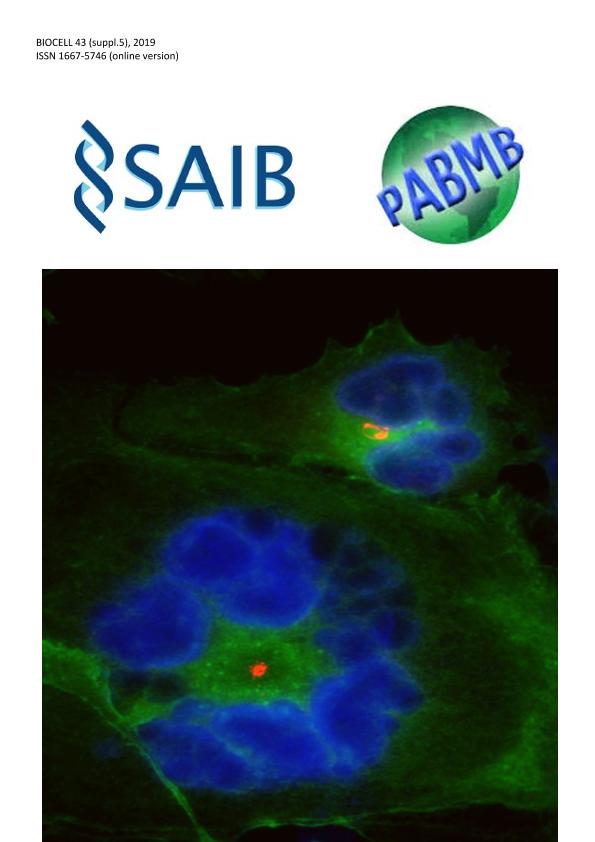Evento
α-Synuclein and lipid metabolism: intersecting pathways
Alza, Natalia Paola ; Conde, Melisa Ailén
; Conde, Melisa Ailén ; Scodelaro Bilbao, Paola Gabriela
; Scodelaro Bilbao, Paola Gabriela ; González Pardo, Verónica; Salvador, Gabriela Alejandra
; González Pardo, Verónica; Salvador, Gabriela Alejandra
 ; Conde, Melisa Ailén
; Conde, Melisa Ailén ; Scodelaro Bilbao, Paola Gabriela
; Scodelaro Bilbao, Paola Gabriela ; González Pardo, Verónica; Salvador, Gabriela Alejandra
; González Pardo, Verónica; Salvador, Gabriela Alejandra
Tipo del evento:
Reunión
Nombre del evento:
The LV Annual SAIB Meeting and XIV PABMB Congress
Fecha del evento:
05/11/2019
Institución Organizadora:
Sociedad Argentina de Investigación Bioquímica y Biología Molecular;
Título de la revista:
Biocell
Editorial:
Tech Science Press
e-ISSN:
1667-5746
Idioma:
Inglés
Clasificación temática:
Resumen
α-synuclein (α-syn) aggregation and fibrillation is a hallmark of a class of neurodegenerative disorders known as synucleinopathies. An intriguing and not completely clarified feature of α-syn is the many ways in which it interacts with lipids. In the present study, we aimed to investigate the effect of α-syn overexpression on neuronal lipid metabolism. For this purpose, human IMR-32 neuroblastoma cells stably transfected with either pcDNA3 vector (control) or pcDNA3-WT-α-syn (WT α-syn) were used. We observed that α-syn overexpression induced the accumulation of cytosolic lipid droplets (LD) and cholesterol (Chol) in lysosomes. LD increase was coincident with a rise in triacylglycerol (TAG) and Chol esters content. To ascertain the mechanism involved in LD accumulation, pharmacological inhibitors of proteasomal degradation and autophagy were used. Whereas autophagy inhibition did not affect neutral lipids content, the blockage of proteasomal degradation was able to increase LD accumulation in WT α-syn cells. In silico analysis performed with MyProteinNet server (Yeger-Lotem lab) postulates a positive correlation between α-syn and sterol regulatory element-binding gen (SREBF-2). To corroborate these data in our experimental model, we evaluated the status of the transcription factors SREBP-1 and SREBP-2. SREBP-1 nuclear localization was slightly diminished by α-syn overexpression with decreased levels of fatty acid synthase protein expression. In contrast, α-syn overexpression promoted SREBP-2 nuclear translocation, with no increment in the expression levels of the downstream genes related to Chol synthesis. Intriguingly, fatty acid Coenzyme A esterification and acylation into Chol and diacylglycerides were increased in WT α-syn cells. To elucidate the source of fatty acids availability, we measured phospholipid content and TAG hydrolysis. WT α-syn cells displayed diminished levels of cardiolipin and phosphatidic acid with no changes in TAG hydrolysis. Our results allow us to conclude that: α-syn overexpression induces a metabolic switch that triggers the neuronal accumulation of neutral lipids by activating several mechanisms: (i) increased phospholipid hydrolysis, (ii) a rise in fatty acids esterification into Chol and diacylglycerols, and (iii) Chol accumulation in lysosomes probably due to an increment in its uptake.
Palabras clave:
SYNUCLEINOPATHIES
,
LIPID DROPLETS
,
LIPIDS
,
SYNUCLEIN
Archivos asociados
Licencia
Identificadores
Colecciones
Eventos(INIBIBB)
Eventos de INST.DE INVEST.BIOQUIMICAS BAHIA BLANCA (I)
Eventos de INST.DE INVEST.BIOQUIMICAS BAHIA BLANCA (I)
Citación
α-Synuclein and lipid metabolism: intersecting pathways; The LV Annual SAIB Meeting and XIV PABMB Congress; Salta; Argentina; 2019; 1-6
Compartir



